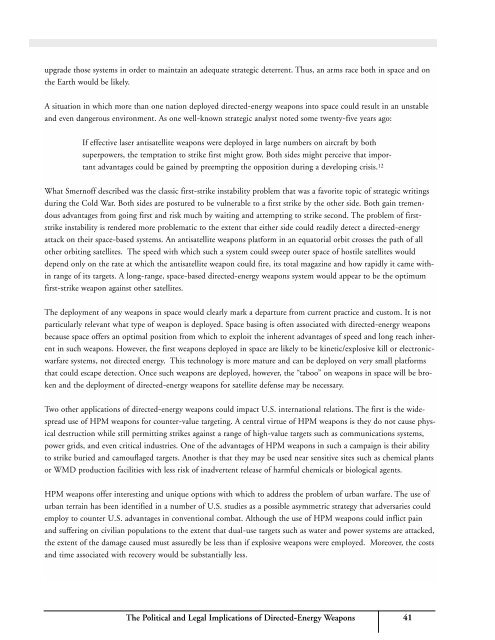directed-energy-weapons
directed-energy-weapons
directed-energy-weapons
Create successful ePaper yourself
Turn your PDF publications into a flip-book with our unique Google optimized e-Paper software.
upgrade those systems in order to maintain an adequate strategic deterrent. Thus, an arms race both in space and onthe Earth would be likely.A situation in which more than one nation deployed <strong>directed</strong>-<strong>energy</strong> <strong>weapons</strong> into space could result in an unstableand even dangerous environment. As one well-known strategic analyst noted some twenty-five years ago:If effective laser antisatellite <strong>weapons</strong> were deployed in large numbers on aircraft by bothsuperpowers, the temptation to strike first might grow. Both sides might perceive that importantadvantages could be gained by preempting the opposition during a developing crisis. 12What Smernoff described was the classic first-strike instability problem that was a favorite topic of strategic writingsduring the Cold War. Both sides are postured to be vulnerable to a first strike by the other side. Both gain tremendousadvantages from going first and risk much by waiting and attempting to strike second. The problem of firststrikeinstability is rendered more problematic to the extent that either side could readily detect a <strong>directed</strong>-<strong>energy</strong>attack on their space-based systems. An antisatellite <strong>weapons</strong> platform in an equatorial orbit crosses the path of allother orbiting satellites. The speed with which such a system could sweep outer space of hostile satellites woulddepend only on the rate at which the antisatellite weapon could fire, its total magazine and how rapidly it came withinrange of its targets. A long-range, space-based <strong>directed</strong>-<strong>energy</strong> <strong>weapons</strong> system would appear to be the optimumfirst-strike weapon against other satellites.The deployment of any <strong>weapons</strong> in space would clearly mark a departure from current practice and custom. It is notparticularly relevant what type of weapon is deployed. Space basing is often associated with <strong>directed</strong>-<strong>energy</strong> <strong>weapons</strong>because space offers an optimal position from which to exploit the inherent advantages of speed and long reach inherentin such <strong>weapons</strong>. However, the first <strong>weapons</strong> deployed in space are likely to be kinetic/explosive kill or electronicwarfaresystems, not <strong>directed</strong> <strong>energy</strong>. This technology is more mature and can be deployed on very small platformsthat could escape detection. Once such <strong>weapons</strong> are deployed, however, the “taboo” on <strong>weapons</strong> in space will be brokenand the deployment of <strong>directed</strong>-<strong>energy</strong> <strong>weapons</strong> for satellite defense may be necessary.Two other applications of <strong>directed</strong>-<strong>energy</strong> <strong>weapons</strong> could impact U.S. international relations. The first is the widespreaduse of HPM <strong>weapons</strong> for counter-value targeting. A central virtue of HPM <strong>weapons</strong> is they do not cause physicaldestruction while still permitting strikes against a range of high-value targets such as communications systems,power grids, and even critical industries. One of the advantages of HPM <strong>weapons</strong> in such a campaign is their abilityto strike buried and camouflaged targets. Another is that they may be used near sensitive sites such as chemical plantsor WMD production facilities with less risk of inadvertent release of harmful chemicals or biological agents.HPM <strong>weapons</strong> offer interesting and unique options with which to address the problem of urban warfare. The use ofurban terrain has been identified in a number of U.S. studies as a possible asymmetric strategy that adversaries couldemploy to counter U.S. advantages in conventional combat. Although the use of HPM <strong>weapons</strong> could inflict painand suffering on civilian populations to the extent that dual-use targets such as water and power systems are attacked,the extent of the damage caused must assuredly be less than if explosive <strong>weapons</strong> were employed. Moreover, the costsand time associated with recovery would be substantially less.The Political and Legal Implications of Directed-Energy Weapons41


